|
Event Index
 Event Management is accessible through <baseURL>/admin/ URL. This page will show a list of current
events defined (as can be seen in the image to the right, click on it to see a full image).
Event Management is accessible through <baseURL>/admin/ URL. This page will show a list of current
events defined (as can be seen in the image to the right, click on it to see a full image).
Events will show in each defined category.
The Event Index table shows the following information:
- Event Name - displayes event's name
- Event Title - displays event's title
- Open for Registation - Yes/No field indicating if event currently allows registration
- Multiple Registration - Yes/No field indicating if event allows to register more than once.
- Regstration Stats - Numeric value indicating how many places in the event are taken, out of the total available
- Actions - Four links that allow control over the event: View Edit Audit and Delete
Back to the Table of Contents
Navigation
 Each page in the admin area will display the links displayed in the image (right),
at the top of the page, on the right hand side.
Each page in the admin area will display the links displayed in the image (right),
at the top of the page, on the right hand side.
- New Event - Opens the new event dialog
- Edit Categories - Allows editing of event categories
- Event Index - will redirect back to the Event Index Page
Back to the Table of Contents
Adding & Editing Events
Clicking the "New Event" link, or choosing "Edit" will lead to this dialog.
It is similar for both Add and Edit. Differences between the two action will be discussed at the
bottom of this section.
The dialog is displayed in 4 boxes, described here separately, but in reality display
together on the same page:
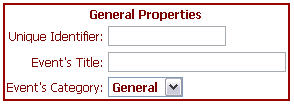 General Properties
General Properties
These are the basic definitions of the event, all mandatory:
- Unique Identifier - this field is the main ID for the event. It must be in English,
and alpha-numeric, with no spaces or special characters in it.
- Event's Title - This text will be used as the title when displaying the event.
Should be as descriptive as possible.
- Event's Category - list box that assigns the event to a category. See
here for more on categories.
 Registration Options
Registration Options
This section deals with all aspects of Registration, and it divided into two parts:
User Registration Options
- Event is closed for registration checkbox - allows closing the event for user registration.
You can re-enable registration be removing this check at a later time.
- Participants can register up to X times - This will define the amount of times a user is
allowed to register in the event. Zero will allow unlimited registration, any other positive number will
limit the user to that amount.
- Participants are allowed to delete themselves - This option does not work at this time.
- Event Admin's Email - Email address that will be displayed in error messages (like when trying to
register too many times). Usually the email of the person in charge of this event.
Registration Dialog Options
When the user register s/he will presented with a pop-up window that will ask for registration information.
This section control options for that window.
- Title - Text string to be displayed in the window, prompting the user to provide login information.
- First Field Name - Title to put by the first input field in that window.
- Second Field Name - Title to put by the second input field in that window.
- Second field is a password - If checked second field will be displayed as a password,
and typing in that field will not show the letters typed.
- Use Authentication Function - This will assign which authentication func. to use to verify
user's credentials. See discussion of Auth Functions
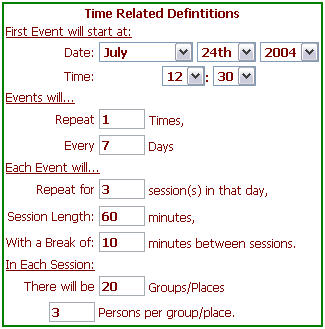 Time Related Definitions
Time Related Definitions
This section is at the heart of the module. It allows definition of a repetative event of the following
format: Each event will repeat a few times, every X days. In each such event you (may) have multiple
sessions, that occur in set intervals, and each session can have a set amount of places, where one place
can allow for 1 or more people. (Like in a class that has 10 computers, where 2 students will sit at each
computer - allowing for 20 places.)
Lets see if I can make it clearer while explaining the dialog to the right:
- First Event will start at: - Defines the date/time of the first event. All other times
and events are calculated as set intervals/jumps from that time.
- Events will... - This defines how many times you want the event to occur, with the
interval of days between each event. Say you have 3 classes on Sunday, Tuesday and Thursday, you'd
want to repeat 3 times evey 2 days. (assuming the date/time above were set to the correct time for
Sunday).
- Each Event Will... - This divides the event into sessions within the day. You may have
multiple sessions in that day, each with a defined length, and with a defined break between them.
Say there are 4 lessons, each taking 1 hour, then half our break (and a new lesson starts), then
fill in: "Repeat for 4 sessions... 60 minutes, 30 minutes break". (Again, base time
for these calculations is the time defined above. Also, note that the module will allocate
places for each session in the event.)
- In Each Session: - this defines the number of places in your session, where 1 place
can allow for more than one person. (Again, for the event where you have a lab with 10 computers,
and you want to seat more than one person near each computer.)
A Little Math:
{Places in 1 Session} = {Num of Places} x {Num of Persons per place}
{Places in 1 day event} = {Places in 1 Session} x {Num of Sessions}
{Places in the whole event} = {Places in 1 day event} x {Num of days event repeats}
(Now imagine you'd have to do it manually...)
HTML Definitions
This section allows the definition of a page header and a page footer
(See this image) that will display at the top and bottom
of the event page. The text can contain HTML code, like lists or tables, and will be displayed in a
framed box at the top/bottom accordingly.
The header/footer are used to display information about the event for the registering users,
like terms, limitations and instructions.
The "Commit" button at the bottom of the page will save changes made to the event.
Back to the Table of Contents
Edit Dialog
The Edit Dialog allows editing of an existing event, and is essentially similar to the
Add dialog with the following differences:
- The dialog title displays the event title with two links that allow to
View and Audit the event.

- The Unique Identifier field is not editable. This field is set
once when the event is added and is not allowed to be chagned.
- Some Time-Related Definitions will be disabled only if users
have already registered to the event. This is due to the fact that changing these fields
after users are registered will shift registered users to slots others than where they registered
in the first place. The disabled fields are: Numer of sessions per event, Numer of places per
session and Numer of people per place. All other time fields are allowed to be changed.
A message explaining why the fields are disabled will appear under the Time-Definition box:
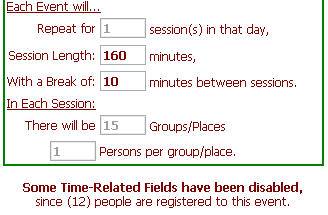
- The button at the bottom of the page will change from "Commit" to "Update"
to indicate updating of an exsiting event.
Back to the Table of Contents
View Event
The "View Event" link appears both in the index table in the "Actions"
section for each event, and in the "Edit Event" dialog.
It will redirect to the page displaying the event, and allowing for user registration.
This is comfortable if you want to review the event and check how it will look to the regular user.
Back to the Table of Contents
Audit Event
Event Auditing allows the administrator to manage registered users, using an easy graphical interface to
move users around the event, or delete them from the event.
The admin can reach Audit mode by following the "Audit" link in the Index Table
or from the Edit Dialog. Once in that screen, the admin is displayed with the event
layout (similar to what the user sees). However, in this screen the admin can perform changes regular users
cannot:
Swithing between the modes:
There are two audit modes that are toggled through the botton which displays in the top middle.
Pressing the button will change between the modes: (back and forth)

In "Move Mode" the admin can move a user from the place he currently occupies to an
empty place. This is done by clicking the user's cell (which will turn blue), and then clicking
the destination empty cell (which will turn green). A popup window will ask to verify the move:
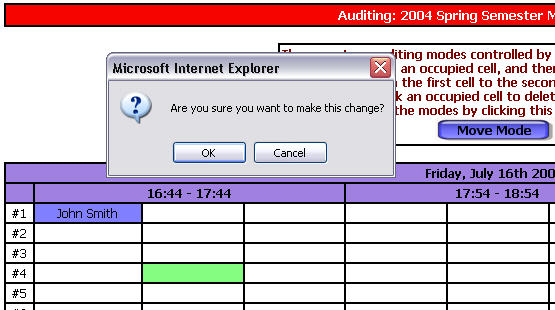
Pressing OK will verify the move, Cancel will abort it.
Also, if you've chosen a user to move, you can abort the move by clicking the cell again (will turn off
the blue lighting), or by chosing a different user (the new user's cell will light blue instead).

Delete mode is similar, but has only 1 step. First toggle to del-move using the button. Then simply
click on an occupied cell, the cell will light red, and a popup window will appear to confirm the delete:
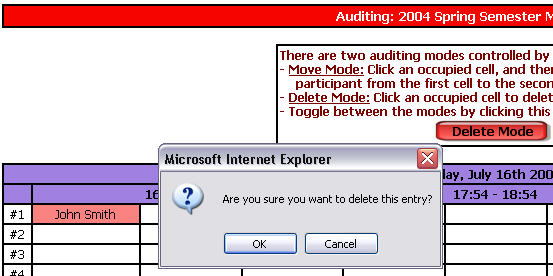
Remember that delete operations are permanent once confirmed.
Back to the Table of Contents
Delete Event
An even can be deleted, along with all data associated with it, meaning it's cnnfiguration
and all registration information will be permanently deleted from the database.
Delete operation can be performed by pressing the "Delete" link of a specific event in the
Events Index. The action will be confirmed by a popup dialog.
Back to the Table of Contents
Category Management
Categories allow events to be assigned to a predefined topic / categories. It's easier to manage and view events
in this manner, since it's generally easier on the admin and end-user to see a categorized list,
and also, it allows to show the end user a list of events for a certain topic/category only.
 You can manage categories easily by clicking the "Edit Categories" link in the
Navigation Menu. A dialog window will appear (see right).
You can manage categories easily by clicking the "Edit Categories" link in the
Navigation Menu. A dialog window will appear (see right).
The dialog is simple:
- Use the top links to navigate the dialog
- Use the "Close Window" link at the bottom to close this window
- Use the "New Category" link to add a new category
- Use the "Category List" link to return to the list.
- Use the "Edit" and "Delete" links to perform these actions on each category.
Back to the Table of Contents
|
 A full listing of events (by category) will be displayed when the URL of arsLab is accessed through
the web. The user will get a page similar to the one displayed right.
A full listing of events (by category) will be displayed when the URL of arsLab is accessed through
the web. The user will get a page similar to the one displayed right.
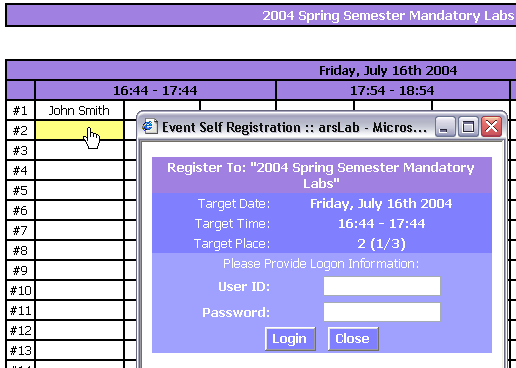




 Each page in the admin area will display the links displayed in the image (right),
at the top of the page, on the right hand side.
Each page in the admin area will display the links displayed in the image (right),
at the top of the page, on the right hand side.






 You can manage categories easily by clicking the "Edit Categories" link in the
You can manage categories easily by clicking the "Edit Categories" link in the